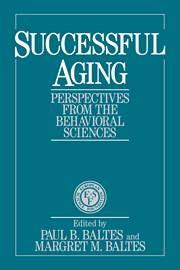Book contents
- Frontmatter
- Contents
- List of contributors
- Foreword
- Preface
- 1 Psychological perspectives on successful aging: The model of selective optimization with compensation
- 2 Medical perspectives upon successful aging
- 3 Successful aging in a post-retired society
- 4 The optimization of cognitive functioning in old age: Predictions based on cohort-sequential and longitudinal data
- 5 The optimization of episodic remembering in old age
- 6 Peak performance and age: An examination of peak performance in sports
- 7 Personal control over development and quality of life perspectives in adulthood
- 8 Successful mastery of bereavement and widowhood: A life-course perspective
- 9 The Bonn Longitudinal Study of Aging: Coping, life adjustment, and life satisfaction
- 10 Risk and protective factors in the transition to young adulthood
- 11 Avoiding negative life outcomes: Evidence from a forty-five year study
- 12 Developmental behavioral genetics and successful aging
- Name index
- Subject index
6 - Peak performance and age: An examination of peak performance in sports
Published online by Cambridge University Press: 22 March 2010
- Frontmatter
- Contents
- List of contributors
- Foreword
- Preface
- 1 Psychological perspectives on successful aging: The model of selective optimization with compensation
- 2 Medical perspectives upon successful aging
- 3 Successful aging in a post-retired society
- 4 The optimization of cognitive functioning in old age: Predictions based on cohort-sequential and longitudinal data
- 5 The optimization of episodic remembering in old age
- 6 Peak performance and age: An examination of peak performance in sports
- 7 Personal control over development and quality of life perspectives in adulthood
- 8 Successful mastery of bereavement and widowhood: A life-course perspective
- 9 The Bonn Longitudinal Study of Aging: Coping, life adjustment, and life satisfaction
- 10 Risk and protective factors in the transition to young adulthood
- 11 Avoiding negative life outcomes: Evidence from a forty-five year study
- 12 Developmental behavioral genetics and successful aging
- Name index
- Subject index
Summary
Introduction
The growing interest in “testing the limits” and “maximum performance” (Baltes, 1987; Kliegl & Baltes, 1987) comes in part from the realization that traditional research does not seem able to obtain valid measures of performance, especially in old subjects. Recent research has shown that the inferior performance of old subjects can be substantially improved by briefly familiarizing them with the test situation, allowing further practice, and giving short-term instruction in efficient strategies for approaching the task (Baltes & Willis, 1982). Furthermore, potential differences in the motivation to perform in young and old subjects is a difficult issue in research on aging.
One approach to dealing with the influence of practice effects is to provide old and young subjects with considerable practice and to examine age differences in results (Kliegl, Smith, & Baltes, 1986; Salthouse & Somberg, 1982). However, even toward the end of extended practice, the performance of both young and old subjects continues to improve and has not reached a stable limit or peak performance. The approach described in this chapter is to seek out subjects who try to attain their best performance in real life. These subjects have spent orders of magnitude more time and effort on improving their performance than could ever be possible within a laboratory setting. Peak performance therefore refers to the best possible performance individuals are able to achieve when they are striving for this performance over an unlimited period of time.
- Type
- Chapter
- Information
- Successful AgingPerspectives from the Behavioral Sciences, pp. 164 - 196Publisher: Cambridge University PressPrint publication year: 1990
- 30
- Cited by



